
John P. Healey
Encyclopedia
John P. Healey is an executive manager best known for his role in the redesign and manufacture of the command modules
for the Apollo program
after the catastrophic launch pad fire that took the lives of Command Pilot Virgil I. "Gus" Grissom
, Senior Pilot Ed White
and Pilot Roger B. Chaffee
on January 27, 1967 (Apollo 1).
and played soccer in the state tournament against Annapolis.
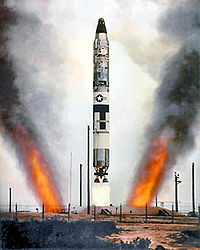
The lifting power and reliability of Titan missiles led to its selection and use in the NASA
Gemini program of manned space capsules in the mid-1960s. Twelve Titan IIs were used to launch two U.S. unmanned Gemini test launches and ten manned capsules with two-man crews. All of the launches were successes.
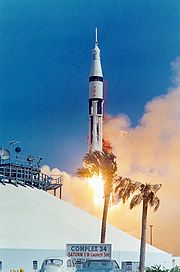 After the catastrophic launch pad fire that took the lives of Command Pilot Virgil I. "Gus" Grissom
After the catastrophic launch pad fire that took the lives of Command Pilot Virgil I. "Gus" Grissom
, Senior Pilot Ed White
and Pilot Roger B. Chaffee
(January 1967), Healey was recruited by Bill Bergen, President of North American Aviation Space Division
, as the spacecraft manager for the redesign of the Apollo
Command Module (November 1967).
Healey was expected to set precedents in guiding a nearly perfect spacecraft through the factory. Many doubted, Bergen later said, that the recovery could be made in a reasonable time because "everything had come to a screeching halt." Bergen credited the assignment of Borman
and his group, and Healey's performance as manager of spacecraft as the keys to getting command module production back into line. When the command module (Block II Apollo CSM-101) arrived at the Cape (May 1968), the receiving inspectors found fewer discrepancies than on any spacecraft previously delivered to Kennedy space center
. By the end of the program, Healey was Rockwell
's VP for Apollo and Stage II of the Saturn V
rocket.
.jpg)
program; a supersonic strategic bomber
designed to replace the aging B-52.
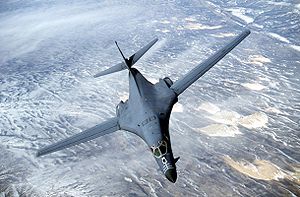 The B-1A mockup review had occurred in late October 1971 and there had been 297 requests for alterations. Under Healey’s management, the first of four prototype B-1A models (s/n 74-0158) flew on 23 December 1974. Due to the politics of the era and programs competing for funding, it would be more than a decade before the first production B-1B aircraft would fly.
The B-1A mockup review had occurred in late October 1971 and there had been 297 requests for alterations. Under Healey’s management, the first of four prototype B-1A models (s/n 74-0158) flew on 23 December 1974. Due to the politics of the era and programs competing for funding, it would be more than a decade before the first production B-1B aircraft would fly.
During this period Healey was responsible for upgrading Rockwell’s civilian aircraft, the Commander 112/114, and bringing them to an efficient production level. Engines were replaced with more powerful versions, the wing was redesigned internally to increase fuel capacity, and a turbo-charged model was introduced. As the market potential for this class of civilian aircraft later declined, Rockwell sold this line to Gulfstream American
who discontinued production.
 Healey left Rockwell to manage a military aircraft program taking the Fairchild-Republic A-10 Thunderbolt II
Healey left Rockwell to manage a military aircraft program taking the Fairchild-Republic A-10 Thunderbolt II
, a close air support
(CAS) aircraft, from prototype to production. Selected by the Air Force over its rival from Northrop
, the YA-9, in January 1973, the first production A-10 flew in October 1975 and deliveries to operational units commenced within 6 months.
Healey then joined System Development Corporation
(SDC) as an executive manager for ongoing government contracts with the Department of Defense
(DoD), National Aeronautics and Space Administration (NASA
), Department of Energy
(DoE), and other government agencies. In 1980, SDC was acquired by the Burroughs Corporation and later merged with the Sperry Corporation
to form Unisys
. Healey promoted the development of program control systems and the automation of project management throughout his career and was retired from Unisys.
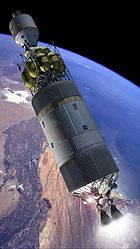 Healey, coming out of retirement, joined the Lockheed Martin Orion team in 2008.
Healey, coming out of retirement, joined the Lockheed Martin Orion team in 2008.
The Orion
Crew and Service Module (CSM) designs are based substantially on the Apollo Command and Service Modules
(Apollo CSM) flown between 1967 and 1975, but include advances derived from other technology programs, including; control systems from the Boeing 787
, “autodock” features from Russian/European spacecraft, waste-management systems based on Skylab
, the Space Shuttle
, and the International Space Station
, and the most advanced computers ever put into a spacecraft. "Going with known technology and known solutions lowers the risk," according to Neil Woodward, director of the integration office in the Exploration Systems Mission Directorate.
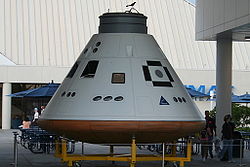 The goals of Orion
The goals of Orion
include:
It is an element of NASA's Project Constellation
, which plans to send human explorers
back to the Moon
by 2020, and then onward to Mars
and other destinations in the Solar System
.
Apollo Command/Service Module
The Command/Service Module was one of two spacecraft, along with the Lunar Module, used for the United States Apollo program which landed astronauts on the Moon. It was built for NASA by North American Aviation...
for the Apollo program
Project Apollo
The Apollo program was the spaceflight effort carried out by the United States' National Aeronautics and Space Administration , that landed the first humans on Earth's Moon. Conceived during the Presidency of Dwight D. Eisenhower, Apollo began in earnest after President John F...
after the catastrophic launch pad fire that took the lives of Command Pilot Virgil I. "Gus" Grissom
Gus Grissom
Virgil Ivan Grissom , , better known as Gus Grissom, was one of the original NASA Project Mercury astronauts and a United States Air Force pilot...
, Senior Pilot Ed White
Edward Higgins White
Edward Higgins White, II was an engineer, United States Air Force officer and NASA astronaut. On June 3, 1965, he became the first American to "walk" in space. White died along with fellow astronauts Gus Grissom and Roger Chaffee during a pre-launch test for the first manned Apollo mission at...
and Pilot Roger B. Chaffee
Roger B. Chaffee
Roger Bruce Chaffee was an American aeronautical engineer and a NASA astronaut in the Apollo program. Chaffee died along with fellow astronauts Gus Grissom and Ed White during a pre-launch test for the Apollo 1 mission at Cape Kennedy...
on January 27, 1967 (Apollo 1).
Early life and education
Healey grew up on Normal Ave. in Baltimore, Maryland, the son of Irish immigrants. His father was a stone cutter and his mother worked as a maid. As a boy, he attended St. Paul’s elementary school where he played baseball while working for the local grocer after school. He attended Baltimore City CollegeBaltimore City College
The Baltimore City College , also referred to as The Castle on the Hill, historically as The College, and most commonly City, is a public high school in Baltimore, Maryland, U.S.A. The City College curriculum includes the International Baccalaureate Programme and emphasizes study in the classics...
and played soccer in the state tournament against Annapolis.

From aircraft to missiles
After serving in the Navy during WWII, Healey went to work for the Glen L. Martin Company in Baltimore, Maryland. From his start as an aircraft quality inspector to his role leading manufacturing and quality control for the Titan missile program, he gained a reputation for being tough but fair, and for his ability to motivate the organization to get the job done right.The lifting power and reliability of Titan missiles led to its selection and use in the NASA
NASA
The National Aeronautics and Space Administration is the agency of the United States government that is responsible for the nation's civilian space program and for aeronautics and aerospace research...
Gemini program of manned space capsules in the mid-1960s. Twelve Titan IIs were used to launch two U.S. unmanned Gemini test launches and ten manned capsules with two-man crews. All of the launches were successes.
Apollo program

Gus Grissom
Virgil Ivan Grissom , , better known as Gus Grissom, was one of the original NASA Project Mercury astronauts and a United States Air Force pilot...
, Senior Pilot Ed White
Edward Higgins White
Edward Higgins White, II was an engineer, United States Air Force officer and NASA astronaut. On June 3, 1965, he became the first American to "walk" in space. White died along with fellow astronauts Gus Grissom and Roger Chaffee during a pre-launch test for the first manned Apollo mission at...
and Pilot Roger B. Chaffee
Roger B. Chaffee
Roger Bruce Chaffee was an American aeronautical engineer and a NASA astronaut in the Apollo program. Chaffee died along with fellow astronauts Gus Grissom and Ed White during a pre-launch test for the Apollo 1 mission at Cape Kennedy...
(January 1967), Healey was recruited by Bill Bergen, President of North American Aviation Space Division
North American Aviation
North American Aviation was a major US aerospace manufacturer, responsible for a number of historic aircraft, including the T-6 Texan trainer, the P-51 Mustang fighter, the B-25 Mitchell bomber, the F-86 Sabre jet fighter, the X-15 rocket plane, and the XB-70, as well as Apollo Command and Service...
, as the spacecraft manager for the redesign of the Apollo
Project Apollo
The Apollo program was the spaceflight effort carried out by the United States' National Aeronautics and Space Administration , that landed the first humans on Earth's Moon. Conceived during the Presidency of Dwight D. Eisenhower, Apollo began in earnest after President John F...
Command Module (November 1967).
Healey was expected to set precedents in guiding a nearly perfect spacecraft through the factory. Many doubted, Bergen later said, that the recovery could be made in a reasonable time because "everything had come to a screeching halt." Bergen credited the assignment of Borman
Frank Borman
Frank Frederick Borman, II is a retired NASA astronaut and engineer, best remembered as the Commander of Apollo 8, the first mission to fly around the Moon, making him, along with fellow crew mates Jim Lovell and Bill Anders, the first of only 24 humans to do so...
and his group, and Healey's performance as manager of spacecraft as the keys to getting command module production back into line. When the command module (Block II Apollo CSM-101) arrived at the Cape (May 1968), the receiving inspectors found fewer discrepancies than on any spacecraft previously delivered to Kennedy space center
Kennedy Space Center
The John F. Kennedy Space Center is the NASA installation that has been the launch site for every United States human space flight since 1968. Although such flights are currently on hiatus, KSC continues to manage and operate unmanned rocket launch facilities for America's civilian space program...
. By the end of the program, Healey was Rockwell
Rockwell International
Rockwell International was a major American manufacturing conglomerate in the latter half of the 20th century, involved in aircraft, the space industry, both defense-oriented and commercial electronics, automotive and truck components, printing presses, valves and meters, and industrial automation....
's VP for Apollo and Stage II of the Saturn V
Saturn V
The Saturn V was an American human-rated expendable rocket used by NASA's Apollo and Skylab programs from 1967 until 1973. A multistage liquid-fueled launch vehicle, NASA launched 13 Saturn Vs from the Kennedy Space Center, Florida with no loss of crew or payload...
rocket.
.jpg)
Apollo 7Apollo 7Apollo 7 was the first manned mission in the American Apollo space program, and the first manned US space flight after a cabin fire killed the crew of what was to have been the first manned mission, AS-204 , during a launch pad test in 1967...
(October 1968), the first manned Apollo mission, was a test flight and confidence-builder with the extensively redesigned command module. Schirra, who would be the only astronaut to fly MercuryMercury programMercury Program might refer to:*the first successful American manned spaceflight program, Project Mercury*an American post-rock band, The Mercury Program...
, Gemini and Apollo missions, commanded this Earth-orbital shakedown of the command and service modules (with Donn Eisele and Walt Cunningham). The Apollo hardware and all mission operations worked without any significant problems and Schirra and Healey remained lifelong friends.
Apollo 8Apollo 8Apollo 8, the second manned mission in the American Apollo space program, was the first human spaceflight to leave Earth orbit; the first to be captured by and escape from the gravitational field of another celestial body; and the first crewed voyage to return to Earth from another celestial...
(December 1968), was the first manned spacecraft to orbit another celestial body.
Apollo 11Apollo 11In early 1969, Bill Anders accepted a job with the National Space Council effective in August 1969 and announced his retirement as an astronaut. At that point Ken Mattingly was moved from the support crew into parallel training with Anders as backup Command Module Pilot in case Apollo 11 was...
(July 1969), was the first landing of a man on the surface of the moon.
Apollo 17Apollo 17Apollo 17 was the eleventh and final manned mission in the American Apollo space program. Launched at 12:33 a.m. EST on December 7, 1972, with a three-member crew consisting of Commander Eugene Cernan, Command Module Pilot Ronald Evans, and Lunar Module Pilot Harrison Schmitt, Apollo 17 remains the...
(December 1972), was the last of the Apollo missions. It marks the last moonwalk and also the last manned mission beyond low Earth orbitLow Earth orbitA low Earth orbit is generally defined as an orbit within the locus extending from the Earth’s surface up to an altitude of 2,000 km...
.
Lancer to system development
After Apollo, Healey was assigned to the Rockwell B-1 LancerB-1 Lancer
The Rockwell B-1 LancerThe name "Lancer" is only applied to the B-1B version, after the program was revived. is a four-engine variable-sweep wing strategic bomber used by the United States Air Force...
program; a supersonic strategic bomber
Strategic bomber
A strategic bomber is a heavy bomber aircraft designed to drop large amounts of ordnance onto a distant target for the purposes of debilitating an enemy's capacity to wage war. Unlike tactical bombers, which are used in the battle zone to attack troops and military equipment, strategic bombers are...
designed to replace the aging B-52.

During this period Healey was responsible for upgrading Rockwell’s civilian aircraft, the Commander 112/114, and bringing them to an efficient production level. Engines were replaced with more powerful versions, the wing was redesigned internally to increase fuel capacity, and a turbo-charged model was introduced. As the market potential for this class of civilian aircraft later declined, Rockwell sold this line to Gulfstream American
Gulfstream Aerospace
Gulfstream Aerospace Corporation is a producer of several models of jet aircraft. Gulfstream has been a unit of General Dynamics since 1999.The company has produced more than 1,500 aircraft for corporate, government, private, and military customers around the world...
who discontinued production.

A-10 Thunderbolt II
The Fairchild Republic A-10 Thunderbolt II is an American single-seat, twin-engine, straight-wing jet aircraft developed by Fairchild-Republic in the early 1970s. The A-10 was designed for a United States Air Force requirement to provide close air support for ground forces by attacking tanks,...
, a close air support
Close air support
In military tactics, close air support is defined as air action by fixed or rotary winged aircraft against hostile targets that are close to friendly forces, and which requires detailed integration of each air mission with fire and movement of these forces.The determining factor for CAS is...
(CAS) aircraft, from prototype to production. Selected by the Air Force over its rival from Northrop
Northrop Corporation
Northrop Corporation was a leading United States aircraft manufacturer from its formation in 1939 until its merger with Grumman to form Northrop Grumman in 1994. The company is known for its development of the flying wing design, although only a few of these have entered service.-History:Jack...
, the YA-9, in January 1973, the first production A-10 flew in October 1975 and deliveries to operational units commenced within 6 months.
Healey then joined System Development Corporation
System Development Corporation
System Development Corporation , based in Santa Monica, California, was considered the world's first computer software company.SDC started in 1955 as the systems engineering group for the SAGE air defense ground system at the RAND Corporation...
(SDC) as an executive manager for ongoing government contracts with the Department of Defense
United States Department of Defense
The United States Department of Defense is the U.S...
(DoD), National Aeronautics and Space Administration (NASA
NASA
The National Aeronautics and Space Administration is the agency of the United States government that is responsible for the nation's civilian space program and for aeronautics and aerospace research...
), Department of Energy
United States Department of Energy
The United States Department of Energy is a Cabinet-level department of the United States government concerned with the United States' policies regarding energy and safety in handling nuclear material...
(DoE), and other government agencies. In 1980, SDC was acquired by the Burroughs Corporation and later merged with the Sperry Corporation
Sperry Corporation
Sperry Corporation was a major American equipment and electronics company whose existence spanned more than seven decades of the twentieth century...
to form Unisys
Unisys
Unisys Corporation , headquartered in Blue Bell, Pennsylvania, United States, and incorporated in Delaware, is a long established business whose core products now involves computing and networking.-History:...
. Healey promoted the development of program control systems and the automation of project management throughout his career and was retired from Unisys.
Back to Our Future (Orion)

The Orion
Orion (spacecraft)
Orion is a spacecraft designed by Lockheed Martin for NASA, the space agency of the United States. Orion development began in 2005 as part of the Constellation program, where Orion would fulfill the function of a Crew Exploration Vehicle....
Crew and Service Module (CSM) designs are based substantially on the Apollo Command and Service Modules
Apollo Command/Service Module
The Command/Service Module was one of two spacecraft, along with the Lunar Module, used for the United States Apollo program which landed astronauts on the Moon. It was built for NASA by North American Aviation...
(Apollo CSM) flown between 1967 and 1975, but include advances derived from other technology programs, including; control systems from the Boeing 787
Boeing 787
The Boeing 787 Dreamliner is a long-range, mid-size wide-body, twin-engine jet airliner developed by Boeing Commercial Airplanes. It seats 210 to 290 passengers, depending on the variant. Boeing states that it is the company's most fuel-efficient airliner and the world's first major airliner to use...
, “autodock” features from Russian/European spacecraft, waste-management systems based on Skylab
Skylab
Skylab was a space station launched and operated by NASA, the space agency of the United States. Skylab orbited the Earth from 1973 to 1979, and included a workshop, a solar observatory, and other systems. It was launched unmanned by a modified Saturn V rocket, with a mass of...
, the Space Shuttle
Space Shuttle
The Space Shuttle was a manned orbital rocket and spacecraft system operated by NASA on 135 missions from 1981 to 2011. The system combined rocket launch, orbital spacecraft, and re-entry spaceplane with modular add-ons...
, and the International Space Station
International Space Station
The International Space Station is a habitable, artificial satellite in low Earth orbit. The ISS follows the Salyut, Almaz, Cosmos, Skylab, and Mir space stations, as the 11th space station launched, not including the Genesis I and II prototypes...
, and the most advanced computers ever put into a spacecraft. "Going with known technology and known solutions lowers the risk," according to Neil Woodward, director of the integration office in the Exploration Systems Mission Directorate.

Orion (spacecraft)
Orion is a spacecraft designed by Lockheed Martin for NASA, the space agency of the United States. Orion development began in 2005 as part of the Constellation program, where Orion would fulfill the function of a Crew Exploration Vehicle....
include:
“to bring to bear the nation's premier human space flight and exploration expertise in the development of NASA's next generation crew transportation system”
“to span five decades in large-scale systems integration, planetary exploration, human space flight systems and operations, launch vehicles, military aircraft, and autonomous flight systems”
“to provide a critical foundation for NASA's vision for space exploration to design, develop and successfully return the only deep space capsule missions since the Apollo era”
It is an element of NASA's Project Constellation
Project Constellation
Constellation Program is a human spaceflight program within NASA, the space agency of the United States. The stated goals of the program were to gain significant experience in operating away from Earth's environment, develop technologies needed for opening the space frontier, and conduct...
, which plans to send human explorers
Human spaceflight
Human spaceflight is spaceflight with humans on the spacecraft. When a spacecraft is manned, it can be piloted directly, as opposed to machine or robotic space probes and remotely-controlled satellites....
back to the Moon
Moon
The Moon is Earth's only known natural satellite,There are a number of near-Earth asteroids including 3753 Cruithne that are co-orbital with Earth: their orbits bring them close to Earth for periods of time but then alter in the long term . These are quasi-satellites and not true moons. For more...
by 2020, and then onward to Mars
Mars
Mars is the fourth planet from the Sun in the Solar System. The planet is named after the Roman god of war, Mars. It is often described as the "Red Planet", as the iron oxide prevalent on its surface gives it a reddish appearance...
and other destinations in the Solar System
Solar System
The Solar System consists of the Sun and the astronomical objects gravitationally bound in orbit around it, all of which formed from the collapse of a giant molecular cloud approximately 4.6 billion years ago. The vast majority of the system's mass is in the Sun...
.

